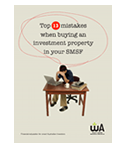Since 2007, there has been an ever increasing interest in using ones superannuation to buy an investment property (via an SMSF). It wasn’t really until 2010 that the strategy started to gain traction as major banks begin offering SMSF loans with competitive interest rates.
In the right situations it is a powerful wealth creating strategy, but far too many investors are trying to do it themselves, without professional guidance, and as a consequence too many mistakes are being made. Here are just a few:
1. Too close to retirement: No. 1 strategic mistake
Borrowing to invest (gearing) is a strategy that requires time for the underlying asset to grow (inflate) in value. A minimum of 7 years and preferably 10.
An appropriate timeline will give you a chance of catching another market cycle in your favour or give you enough time to recover a negative or sluggish start. Gearing too close to retirement is normally a recipe for failure as you will probably be looking at selling the property at a loss (after frictional costs of entry and exist) at retirement to retire debt and free up cash flow to live on.
This is a strategic mistake that should be vigorously avoided.
2. Poor property selection
Unlike managed funds, ETFs or direct shares, where you can buy bits and pieces of many things. With property you cannot buy a bathroom in Chatswood, Sydney and a bedroom in Newstead, Brisbane. It is like an elephant gun, you typically have one bullet and you need to fire it well and accurately.
Investors will readily use professional advisers or managers when it comes to shares but will often go down the DIY road when it comes to a much larger capital allocation involved with a property. Far too many amateurs believe they are competent or above average when it comes to selecting property (the internet, as usual, is partly to blame).
Google has created millions of “experts” that have confused noise, data and information with knowledge, understanding and wisdom.
Here is but a small list of amateur property investor mistakes:
- Confusing price with value. Something cheap is often confused with good value.
- Having an investor’s mentality. Investing in property types that only other investors would consider buying. This excludes the majority of the market who are owner occupiers.
- Over valuing yield and undervaluing likely growth dynamics.
- Taking on too much industry risk in regional areas. Those markets are exposed to one or two employers/industries that provide a large portion of the tenants.
3. No debt repayment strategy
Taking on debt is one thing, but how are you going to pay off the debt?
- Do you have enough time to pay it off?
- Do you have enough contributions to pay it off?
- Are you planning on selling the property to pay it off?
- What type of loan structure are you going to use to give yourself every chance of paying it off?
Just because a bank will lend you money, doesn’t mean you should take it. Borrow conservatively and only do it within the conservative parameters of your SMSF and your contribution capacity. If you borrow money, have a plan to pay it back!
4. Thinking it is a normal transaction
Too many think of it the same way they think of borrowing and buying a property in their own name. Nothing could be further from the truth. There are differences at almost every level of the transaction.
- Asset selection needs to be considered differently
- Finance is harder to get and different
- The legal structure is more expensive and complex
- The accounting is different and more complex
- What you can do with the asset afterwards is different (your daughter cannot rent it from your SMSF for a while!!)
5. Not understanding lending requirements
Getting an SMSF loan is harder than a normal loan. Just because a bank would lend you $500,000 personally, doesn’t mean they will lend you that same amount for your SMSF. If I had to put a rule of thumb on it I would say it’s twice as hard. Deposits need to be much bigger, interest rates are higher, and loan flexibility is reduced.
Don’t set up an SMSF until you have got professional advice about whether your SMSF’s borrowing capacity is sufficient to buy a property. Setting up an SMSF only to find out you cannot borrow as much as you thought to buy a property is an expensive mistake.
6. Buying a property before the SMSF is set up
A classic amateur mistake is to exchange contracts on a property (because you rushed it) before setting up the SMSF or holding Trustee Company. This is potentially a messy and expensive mistake.
7. Regular contributions
To get an SMSF loan you need to have a history of regular contributions. In the absence of that, you need a strong income and are able to put forward an argument that you will make contributions into the future. Either way, there is a strong connection between contributions and borrowing capacity of the SMSF.
Mortgage brokers with SMSF loan experience are priceless allies in navigating the maze of SMSF lending.
8. Cash flow and minimum drawdowns in retirement
If you retire at 60 and start a pension, you will need to draw a minimum 4% of the fund balance each year (5% from 65). Property is an illiquid asset, and a common mistake is not planning well in advance for the liquidity requirements of the SMSF.
If a property nets you 2.5% after all its expenses and then you have the running costs of the SMSF, will you have enough left over to fund the 4-5% annual drawdown? This cash flow squeeze could force you to sell the property if you haven’t planned well for it.
9. Old deeds
It’s hard to imagine that anyone can still make this mistake, but it does happen. If you set up your SMSF before July 2007 you probably have a deed that prohibits borrowing within the SMSF. You need a new deed if you want to borrow for a property.
When in doubt, Read the Deed!
10. One project manager: The Transaction Manager
Buying a property in an SMSF is probably the most complex transaction you will ever be involved in. There are multiple parties and professionals involved:
- Real estate agents
- Vendors
- Vendors lawyers
- Accountants
- Mortgage brokers
- Banks
- Your lawyer
- Financial advisers
Every one of these parties has an important role to play in making sure the transaction is executed accurately. The problem is that they are potentially all pulling in a slightly different direction. Who is the spider in the middle pulling all the strings?
Who is the conductor of this symphony?
Who is the one Transaction Manager?
 |
Get The FREE eBook
Top 13 SMSF Property Mistakes One of the main themes of the last few years has been the strong interest in setting up SMSFs and using them to buy investment property. This is not a strategy for everybody. This eBook has been written to give some insight into the issues that need to be considered and to help you avoid many costly mistakes. |









